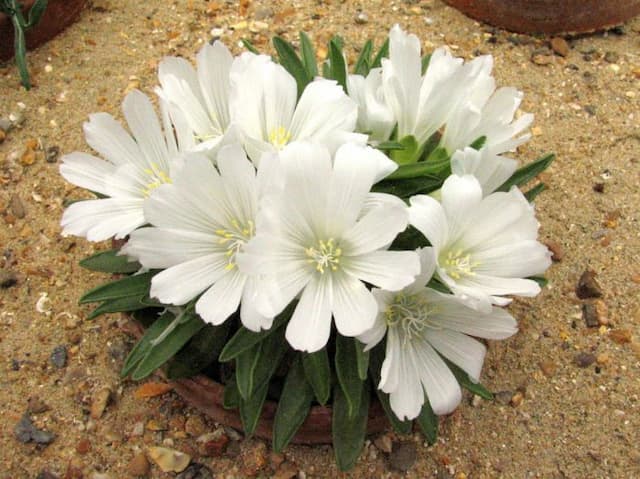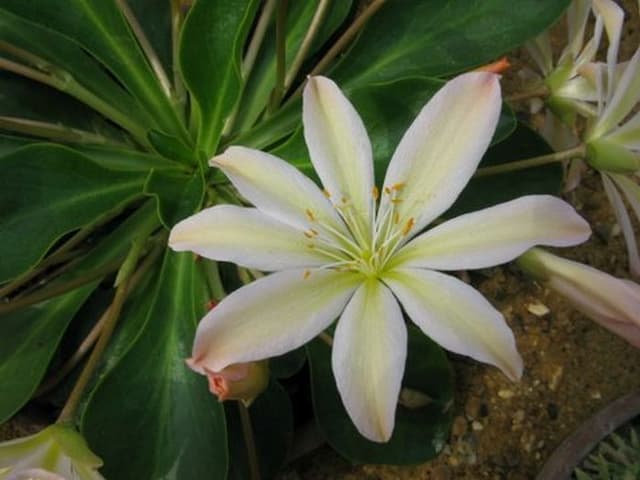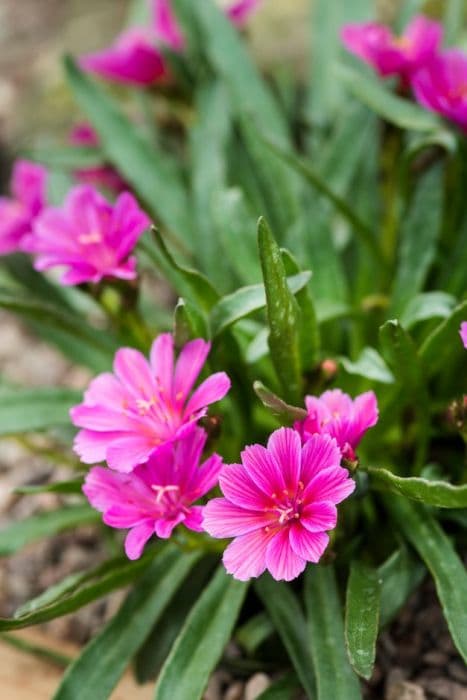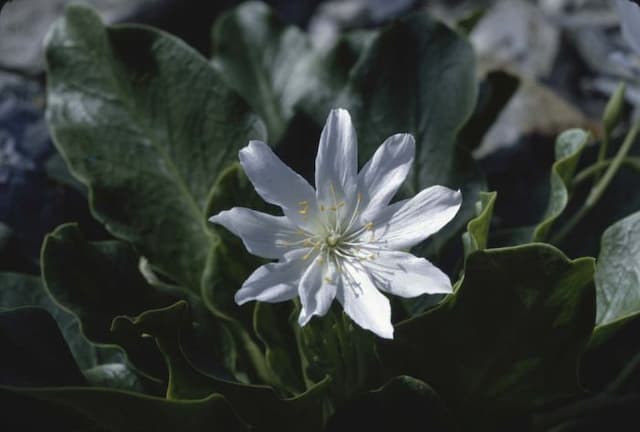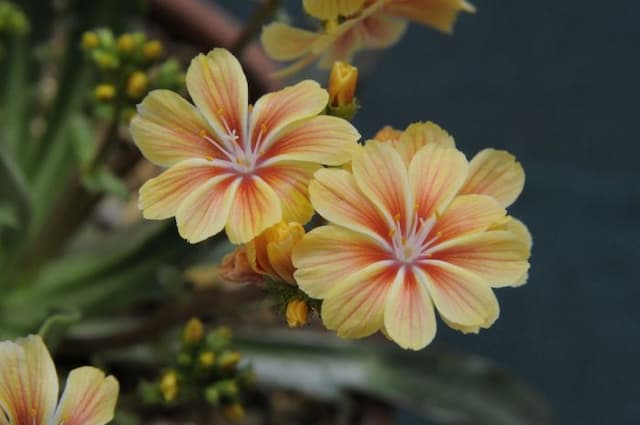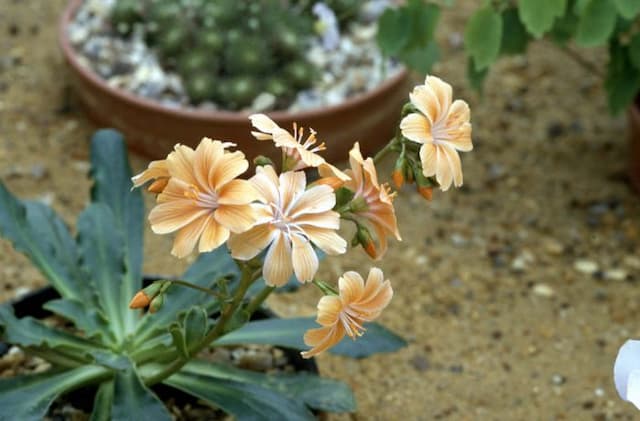Sierran Bitterroot Lewisia cotyledon Ashwood strain

ABOUT
The Lewisia cotyledon Ashwood strain, more commonly known as Siskiyou lewisia, is a striking perennial plant that is valued for its ornamental appeal. The main attraction of this plant is its rosette of fleshy, evergreen leaves that are spoon-shaped with smooth to slightly toothed edges. These leaves create a low-growing, basal clump from which flower stalks emerge. Its flowers are especially showy, blooming in a range of colors from white to deep pink, and can even showcase striking bicolor or multicolored petals. These blossoms are outfitted with numerous petals that radiate outwards, resembling a daisy or a star in shape. These petals surround a central cluster of stamens and pistils, yielding an intricate and eye-catching display. Each flowering stalk of the Siskiyou lewisia supports a cluster of these blooms, held aloft and presenting a dazzling floral display that rises above the greenery, attracting onlookers and pollinators alike. The blossoming of this plant typically occurs in late spring to early summer, adding seasonal charm to the garden. The Siskiyou lewisia is prized for its vibrant and cheerful blooms that make it an exceptional choice for rock gardens, alpine displays, or as a colorful accent in a mixed perennial border.
About this plant
 Names
NamesFamily
Montiaceae.
Synonyms
Siskiyou Lewisia, Cliff Maids, Quillwort.
Common names
Oreobroma cotyledon
 Toxicity
ToxicityTo humans
The plant commonly known as cliff maids is generally considered non-toxic to humans. There are no significant reports of poisoning or adverse effects from ingesting any part of this plant. However, it is always best practice to avoid consuming any part of ornamental plants due to potential unknown individual allergic reactions or irritations.
To pets
The plant commonly referred to as cliff maids is not known to be toxic to pets. There are no widespread reports of pet poisoning from any parts of this plant. As with humans, it's still wise to prevent pets from ingesting plants not intended for consumption, as they could cause gastrointestinal upset or an allergic reaction in sensitive individuals.
 Characteristics
CharacteristicsLife cycle
Perennials
Foliage type
Evergreen
Color of leaves
Green
Flower color
Varies
Height
1 foot [30 cm]
Spread
1 foot [30 cm]
Plant type
Herb
Hardiness zones
5
Native area
California
Benefits
 General Benefits
General Benefits- Ornamental Appeal: Lewisia cotyledon 'Ashwood strain', commonly known as the Bitterroot, is prized for its extensive and vibrant bloom colors, which add aesthetic value to rock gardens, border fronts, and containers.
- Drought Tolerance: Bitterroots are known for their ability to thrive in dry, poor soils, making them ideal for xeriscapes and water-wise gardens.
- Seasonal Interest: With its attractive evergreen rosettes and colorful spring to summer flowers, Bitterroot provides visual interest throughout multiple seasons.
- Compact Growth: The plant's compact habit makes it suitable for small spaces, rockeries, and alpine gardens where it won't overpower neighboring plants.
- Low Maintenance: Bitterroots require minimal upkeep once established, as they are adapted to survive with little watering or fertilization.
- Attracts Pollinators: The brightly colored flowers of the Bitterroot are known to attract bees and butterflies, promoting biodiversity in the garden.
 Medical Properties
Medical PropertiesThis plant is not used for medical purposes.
 Air-purifying Qualities
Air-purifying QualitiesThis plant is not specifically known for air purifying qualities.
 Other Uses
Other Uses- Lewisias, including the Ashwood strain, can be pressed and used in botanical art to create intricate designs and preserve the beauty of the flowers.
- These plants can be cultivated in containers or hanging baskets to beautify balconies and patios due to their compact size and ornamental appearance.
- The blossoms of Lewisia cotyledon can be used to decorate cakes and desserts for edible floral presentations, given they have not been treated with pesticides.
- In photography, Lewisia cotyledon's vibrant colors and patterns make them an excellent subject for macro and nature photography.
- The leaves of Lewisia can be used as a natural dye in textile art to create plant-based pigments for fabric dyeing.
- This plant's ability to thrive in rocky crevices can be utilized in creating living walls or vertical gardens in urban spaces.
- Lewisias can be incorporated in school educational programs to teach children about alpine plant species and biodiversity.
- The Ashwood strain, with its wide variety of colors, can be grown as part of a collector's garden or specialty nursery focusing on rare and unusual plants.
- These plants can be used as a natural way to mark seasonal changes in a garden, as they typically bloom in late spring to early summer.
- Bee and butterfly gardens can include Lewisia cotyledon to attract and provide nectar for a variety of pollinators.
Interesting Facts
 Feng Shui
Feng ShuiThe Lewisia is not used in Feng Shui practice.
 Zodiac Sign Compitability
Zodiac Sign CompitabilityThe Lewisia is not used in astrology practice.
 Plant Symbolism
Plant Symbolism- Resilience: Lewisia cotyledon, commonly known as "Siskiyou lewisia" or simply "Lewisia," often grows in rocky, alpine environments, symbolizing its ability to survive and thrive in challenging conditions and adversity.
- Beauty in Adversity: The Lewisia's ability to produce beautiful flowers in less than ideal soil conditions makes it a symbol of finding beauty in harsh or difficult circumstances.
- Rare Beauty: As Lewisia is not as common as other garden plants and is known for its unique and striking bloom, it represents the uniqueness and rare beauty in the world.
- Overcoming Obstacles: Given its tough nature and ability to grow in cracks and crevices of cliffs, Lewisia embodies the spirit of overcoming obstacles and succeeding despite limitations.
 Water
WaterFor Bitterroot, a prudent approach is to water when the top inch of soil feels dry, typically once a week, but this can vary depending on temperature and humidity. During the growing season, water the plant generously, ensuring it receives an inch of water. In the dormant winter months, reduce watering to prevent root rot, providing just enough to keep the soil slightly moist. Avoid waterlogging by using well-draining soil and a pot with adequate drainage holes. Overwatering or letting the plant sit in water can lead to problems, so it's crucial to monitor the plant's response to your watering routine.
 Light
LightBitterroot thrives in bright indirect light, but it can also tolerate some direct sunlight. The best spot for this plant would be in an east or west-facing window where it receives some morning or late afternoon sun. Too much direct sunlight can lead to leaf burn, while too little light can stunt growth and reduce flowering.
 Temperature
TemperatureBitterroot is best suited to temperatures between 40 and 80 degrees Fahrenheit. Extreme temperatures below 40 degrees or above 85 degrees can damage the plant. The ideal temperature range for this plant's growth is between 60 and 70 degrees Fahrenheit.
 Pruning
PruningPrune Bitterroot to remove dead or damaged foliage and to promote a compact, bushy growth habit. The best time to prune is in late winter or early spring, just before the new growth starts. This will also help rejuvenate the plant and encourage more blooms during its flowering season.
 Cleaning
CleaningAs needed
 Soil
SoilThe bitterroot (Lewisia cotyledon 'Ashwood strain') thrives best in a well-draining soil mix with a slightly acidic to neutral pH of around 5.5 to 6.5. A suitable mix could include equal parts of loam, sand, and perlite or pumice to ensure good drainage which is vital for preventing root rot in this succulent plant.
 Repotting
RepottingThe bitterroot should be repotted every 2 to 3 years to refresh the soil and accommodate root growth. Since they have a deep taproot, choose deep pots and be careful not to damage the root when repotting.
 Humidity & Misting
Humidity & MistingBitterroot prefers moderate to low humidity environments, typical of its native mountainous habitats. It does not require high humidity levels and can tolerate dry air well, making it suitable for typical indoor environments.
 Suitable locations
Suitable locationsIndoor
Provide bright light, fast-draining soil, and minimal water for indoor bitterroot care.
Outdoor
Place in full sun, in well-drained soil, and water sparingly for outdoor bitterroot.
Hardiness zone
4-8 USDA
 Life cycle
Life cycleThe Lewisia cotyledon, commonly known as Siskiyou lewisia or Cliff maids, begins its life cycle as a seed, typically sown in late winter to early spring. The seeds germinate and form rosettes of fleshy, evergreen leaves from which the root system develops to anchor the plant. In late spring to early summer, the plant enters its flowering stage, producing stems topped with clusters of star-shaped flowers in a range of colors, including pink, orange, yellow, and white. After pollination, often by bees and other insects, the flowers will set seeds that mature by late summer. The plant then enters a period of dormancy, especially in areas with hot summers or very cold winters, where growth slows or halts. In the following growing season, the plant resumes growth, and mature specimens may produce offsets, which can be separated and grown as new individuals, continuing the life cycle.
 Propogation
PropogationPropogation time
Spring-Early Summer
The most popular method of propagation for the Lewisia cotyledon, commonly known as Siskiyou lewisia, is through seed sowing. This process is best done in the fall, allowing the seeds to experience a cold period or stratification, which helps improve germination rates. Sow seeds lightly on the surface of a well-draining soil mix, and just barely cover them with a thin layer of soil. The pots or trays should then be kept in a cool, well-lit place but not in direct sunlight; ideal temperatures are around 50 to 55 degrees Fahrenheit (10 to 13 degrees Celsius). Always maintain moist conditions, but avoid waterlogging as this can cause the seeds to rot. The first seedlings typically emerge in late winter or spring, and once they are large enough to handle, they can be transplanted into individual pots.
